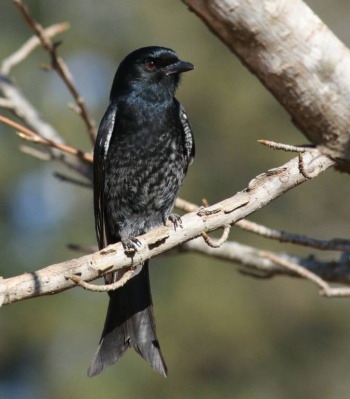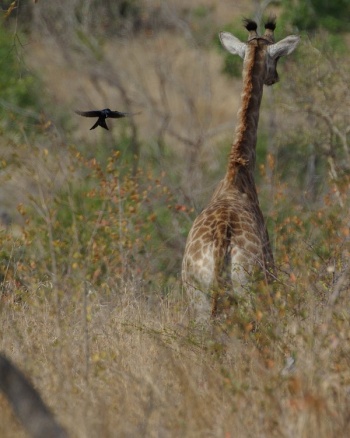Alternative name: African Drongo
- Dicrurus adsimilis
Identification
23–26 cm (9-10 in)
- Glossy black overall plumage
- Wings duller
- Large head
- Forked tail
- Heavy black bill
- Red eye
- Short legs
Female similar but duller

Photo © by Alan Manson
Cedara Farm, Pietermaritzburg, South Africa, 21 August 2007
Similar species
Differs from similar Velvet-mantled Drongo in having tail shorter than wing, a less deep tail fork, slightly less gloss and no pale rictal spot. Square-tailed Drongo and Shining Drongo are smaller and have a less forked tail.
Distribution
The Fork-tailed Drongo is a common and widespread resident breeder in Africa south of the Sahara with being most comon in Botswana, Zimbabwe and the northern parts of South Africa and Mozambique.
Taxonomy
Forms a superspecies with Black Drongo and is sometimes regarded as conspecific.
Subspecies

Photo © by AHH
Kruger National Park, South Africa, 9 July 2007
Four subspecies recognized[1]:
- D. a. divaricatus:
- southwest Mauritania, Senegal, Gambia and Guinea east to northern Cameroon, south Chad, central and south Sudan, Ethiopia, Eritrea and Somalia and south to Central African Republic, northern Democratic Republic of the Congo, northern Uganda and northern Kenya
- D. a. apivorus:
- southeast Gabon and adjacent Congo, patchily in Democratic Republic of the Congo, Angola, Zambia, Namibia, Botswana and northern South Africa
- D. a. fugax:
- Uganda, Kenya and Tanzania south to eastern Zambia, Malawi, Mozambique, Zimbabwe, Botswana, northeast South Africa and east Swaziland
- D. a. adsimilis:
- west Swaziland, Lesotho and east and south South Africa
Habitat
Woodlands including riverine woodlands, moist and arid savanna, forest edges and grassland or fynbos with available perches, plantations of alien trees, gardens, farmyards and town parks.
Behaviour
Actions
Sits very upright whilst perched prominently, like a shrike. An aggressive bird, which will attack much larger species, including birds of prey, snakes and humans, if their nest or young are threatened.
Diet
Their prey is taken aerially and on the ground, and includes flying insects, moths and bees; most often they will sit on a branch and sally out from there, but it may also be sitting on the ground. They are often seen taking prey disturbed by large animals or bush fires. They also often steal food from other birds, and have been known to steal food from suricates and Southern Pied Babblers by sounding false alarms.
Breeding
Monogamous, solitary nester building thin-walled, strongly woven cup nests in high tree-forks. Two to five eggs of highly varying colour.
Vocalisation
The call is a metallic strink-strink. They are also excellent mimics.
Movements
Resident; possibly some short-distance movements in southern part of range.
References
- Clements, J. F., T. S. Schulenberg, M. J. Iliff, S. M. Billerman, T. A. Fredericks, B. L. Sullivan, and C. L. Wood. 2019. The eBird/Clements Checklist of Birds of the World: v2019. Downloaded from http://www.birds.cornell.edu/clementschecklist/download/
- Del Hoyo, J, A Elliott, and D Christie, eds. 2009. Handbook of the Birds of the World. Volume 14: Bush-shrikes to Old World Sparrows. Barcelona: Lynx Edicions. ISBN 978-8496553507
- Birdforum member observations
- Rocamora, G. and D. Yeatman-Berthelot (2020). Fork-tailed Drongo (Dicrurus adsimilis), version 1.0. In Birds of the World (S. M. Billerman, B. K. Keeney, P. G. Rodewald, and T. S. Schulenberg, Editors). Cornell Lab of Ornithology, Ithaca, NY, USA. https://doi.org/10.2173/bow.fotdro5.01
Recommended Citation
- BirdForum Opus contributors. (2024) Fork-tailed Drongo. In: BirdForum, the forum for wild birds and birding. Retrieved 24 April 2024 from https://www.birdforum.net/opus/Fork-tailed_Drongo
External Links




